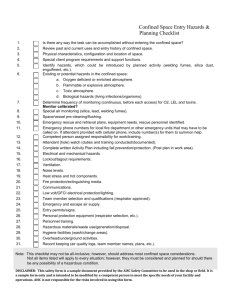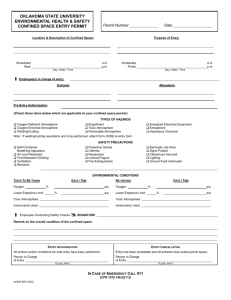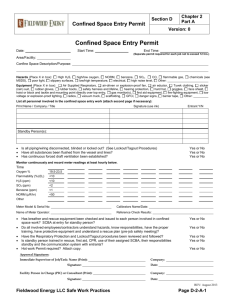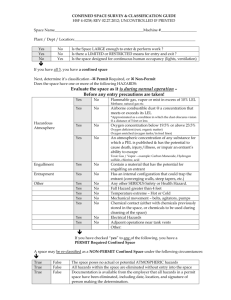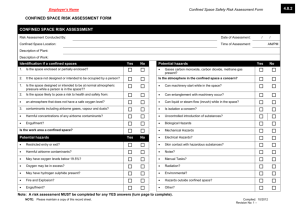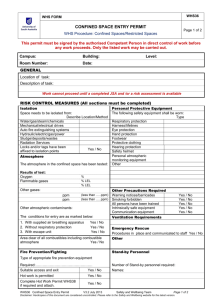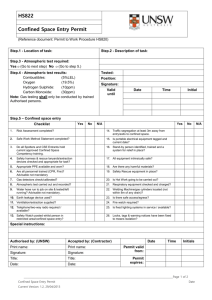Confined Space Entry Plan Environmental Health, Safety, and Risk Management Department
advertisement
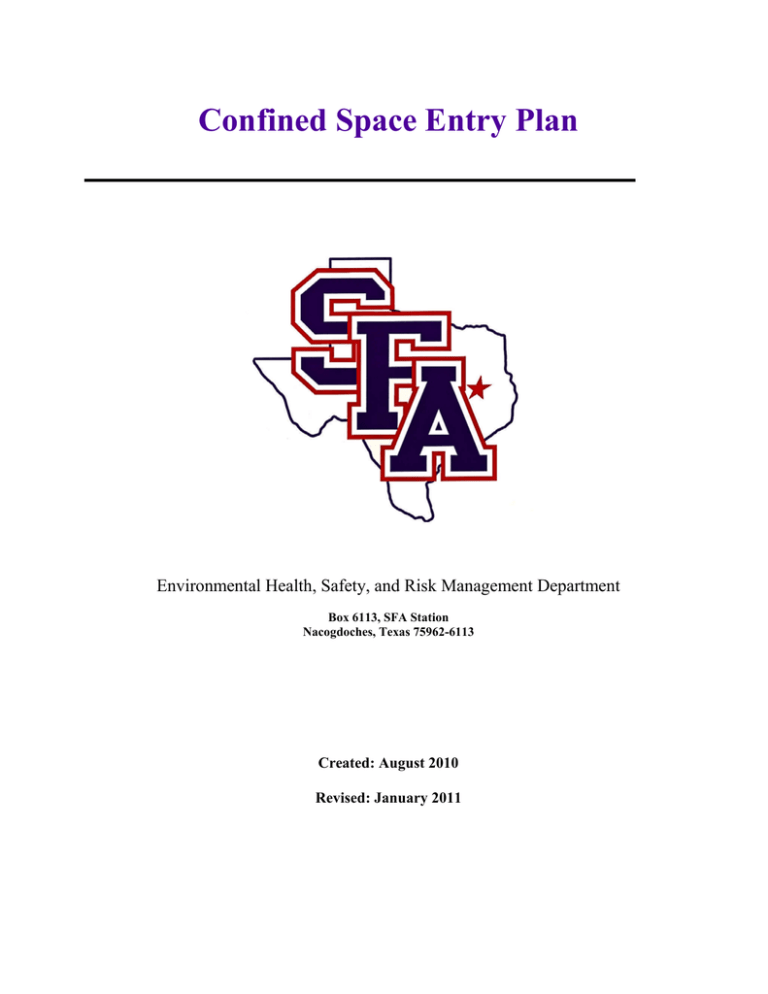
Confined Space Entry Plan Environmental Health, Safety, and Risk Management Department Box 6113, SFA Station Nacogdoches, Texas 75962-6113 Created: August 2010 Revised: January 2011 Purpose • • To establish procedures to protect personnel and prevent injuries when entering and working in confined spaces at Stephen F. Austin State University. To remain in compliance with OSHA regulations, 1910.146. Responsibilities Environmental Health, Safety & Risk Management (EHSRM or Safety Department): EHS&RM is responsible for identifying all confined spaces and compliance with the procedures for confined space entry. EHS&RM shall 1) train supervisors & employees (entrants, attendants, and rescue personnel) annually on identifying existing & potential hazards, confined space procedures, the use of permits, and equipment, 2) audit and/or oversee the confined space entry, and 3) ensure corrective actions are taken when problems arise. Supervisors along with EHS&RM are responsible for training employees on the purpose and use of these procedures. (All employees involved in confined space entry must receive annual training.) Supervisors shall verify that all preparations have been completed to allow for safe entry. The supervisor shall sign and post the permit as well as notify EHS&RM. They will confirm the availability of all rescue service and terminate entry & cancel the permit when the job is completed, there is a change of work crews, or an emergency occurs. The supervisor ensures that acceptable entry conditions are maintained during the operation and that all unauthorized entrants are removed. Entrants: Entrants are the individuals who enter the confined space to work. They must know the hazards associated with the space and properly use all required safety and work equipment. The entrant must communicate with the attendant throughout entry by any effective means. They must immediately exit the space whenever they discover a problem, an emergency occurs, or there are instructed to exit by the attendant, supervisor, or Safety Director. Attendant: The attendant monitors the space and surrounding areas for any problems that might affect the safety of the entrant. They will remain in continuous contact with entrant. The attendant will not enter the confined space. They will be trained in the confined space procedures and aware of the behavioral effects of exposures on the entrants. They will monitor oxygen, toxics, and flammables/explosive levels every 15 minutes. The attendant will summon emergency assistance when needed and may perform non-entry rescue (if properly trained). The attendant will have rescue equipment and a first-aid kit available. They shall prevent unauthorized personnel from entering the confined space. Attendants may not be assigned any duties which could conflict with their primary responsibility of monitoring entrant safety. Definitions Confined Space: A confined space isn’t necessarily a small, crowded area. A confined space has 1) limited or restricted means of entry or exit, 2) unfavorable natural ventilation, 3) not been designed for continuous human occupancy. Examples include: storage tanks, silos, kettles, vault, hopper, pit, trench, boilers, sewers, degreasers, vessels, sumps, diked areas, process tanks & equipment, and pipelines. Permit Required: A permit is required if one of the following hazards is present: 1) hazardous atmosphere, 2) potential for engulfment, 3) internal configuration hazard or 4) other recognized serious safety or health hazards. A copy of the permit is provided in appendix. 1 Hazards Conditions in a confined space can change over time; therefore so can the hazards. Hazards include: Oxygen-deficient atmosphere. An oxygen content of less than 19.5% is considered hazardous. Oxygen-enriched atmosphere. An oxygen content of more than 23.5% is considered hazardous. Flammable or combustible atmosphere. A concentration of a chemical in excess of 10% of its lower explosive, flammable, or combustible limit (LEL) is considered hazardous. Toxic atmosphere. Any chemical exposure in excess of its permissible exposure limit (PEL) is considered hazardous. Engulfment or structural entrapment. Employees can become trapped in liquid or granular material. Inwardly converging walls or floors that taper to a smaller cross-section can trap or asphyxiate an entrant. Energy sources. These include electrical, mechanical, hydraulic, or compressed air. Uncontrolled sources are hazardous. Other hazards. Slips & Falls, Radiation, Heat Stress, Internal configuration, Combustible dust, etc. Procedures No employee or contractor working at Stephen F. Austin State University (SFASU) shall enter a confined space unless absolutely necessary. If necessary: 1. Identify and evaluate the hazards in a space before entry. Evaluation should be done by the supervisor, the employee to enter the confined space, and the attendant stationed outside the confined space. The evaluation form (provided in appendix) following these procedures should be completed prior to entry. If a confined space is identified, it must be appropriately labeled. 2. Determine if a permit is needed. When in doubt, a permit should be completed. Use the permit provided following these procedures when required. 3. The supervisor should inform all employees and contractors of the existence, location of, and danger posed by these spaces. A sign should be posted to indicate that personnel are in the confined space. 4. All equipment in the confined space shall be locked out/tagged out if an accidental energizing of the equipment creates a hazard. If lockout/tagout fails to de-energize the equipment, fuses should be removed from the associated power source. 5. Prior to entry, the confined space should be isolated to preclude entry of all materials. The confined space must be emptied of all hazards. All materials products and liquids shall be removed prior entry, unless additional precautions are taken to prevent engulfment or skin contact during entry. 6. Prior to entry, The Safety Department or supervisor must assure that the confined space is clean, ventilated, and decontaminated to the extent consistent with the hazard. The Safety Department must approve any cleaning or ventilating procedures. 7. The confined space shall be thoroughly ventilated. This should be done mechanically by blowing air into the space or by draft fan venting. No employee shall enter a confined space 2 until adequate ventilation has been provided to purge the atmosphere of the space to meet the air quality criteria. Ventilation shall continue until work is complete in the confined space. 8. If an assessment (testing) of the atmosphere indicates that contamination is present, the cause/source of the contamination must be determined. Furthermore, it must be determined if contamination will increase during entry. Testing should include: • Oxygen Atmosphere Testing. Testing should be done with a calibrated direct-reading oxygen indicator. The oxygen shall contain 19.5-21% oxygen by volume. Measurements should be taken at the top and bottom of the space. Measurements will be taken every 15 minutes by the attendant. Tests must be repeated after a stoppage exceeding 30 minutes. Results should be documented in the permit. Entry is not permitted if the oxygen level is less than 19.5% or greater than 21% • Toxic Atmosphere Testing. If it is determined that any of the following toxins (Toluene, Solvent, Isopropyl Alcohol, H2S or any material that is capable of generating H2S, or any material that has a ceiling PEL (permissible exposure limit) or LEL (lower exposure limit)) were previously contained in the space, testing with color detection tubes (i.e. Drager tubes), chlorine detector, or the biosystems H2S Detector should be conducted. If atmospheric contamination exceeds 10% of the PEL, the space should be ventilated until the level is below 10%. The Safety Department should be contacted if the contamination is immediately dangerous to life of health (IDLH). If toxic gases at IDLH levels exist, entry is not permitted, except for emergency procedures approved by the Safety Department. In that case, the attendant will take measurements every 15 minutes. • Flammable Atmosphere Testing. If the space previously contained or may contain flammable vapors, testing with a combustible gas indicator to determine the concentration of flammable gases and vapors must be conducted. If the concentration of flammable gas or vapors exceeds 5% of the lower flammability limit, the space should be ventilated until the concentration is below 5%. Entry is not permitted if the concentration exceeds 5%. Measurements will be taken every 15 minutes by the attendant. 9. Employees shall wear personal protective equipment such as respiratory protection (i.e. SCBA), gloves, boots, rubber suits, goggles, and harnesses as determined by the Safety Department. Respiratory protection must be worn if 1) there are unknown contaminants in the space, 2) the level of contaminants can not be determined, 3) the potential for IDLH exists, 4) an emergency rescue is being performed, or 5) the potential exists to contaminate the atmosphere while in the space. 10. Portable power tools must be inspected and grounded. Cylinders for cutting and welding torches shall not be taken into the confined space. Ladders must be secured at the top. 3 Rescue Equipment & Procedures Equipment The Safety Department requires the following equipment to be on hand prior to confined space entry: 1. Self-contained breathing apparatus or air-line respirator 2. Harness and lifeline 3. Mechanical retrieval equipment 4. Alarm horn 5. Oxygen/Explosive Meter 6. 12” wide confined space or rope ladder 7. Protective Clothing & equipment 8. Chain/Sling 9. Mechanical Ventilation Rescue Procedures 1. Procedures outlined above are followed. (i.e. Atmospheric tests shall be performed prior to and during entry and documented on the permit, etc.) 2. The attendant is equipped with an alarm horn prior to entry. 3. Any entrant into a vertical exit confined space must wear a parachute type harness. Horizontal exit confined space requires a life line be worn in addition to the harness. 4. Life lines must be attached to a fixed object outside of the confined space. 5. All confined spaces with vertical exits will be equipped with means to attach a lifting winch (i.e. crank with handle, hoist, hauling apparatus with a rope, etc.) for victim rescue (where tripod use is impossible). Training Employees who perform tasked covered by the confined space entry policy (e.g. enter into confined spaces, measure atmospheric conditions in confined spaces, or perform rescue in a confined space) will be trained annually regarding on site procedures and the use of permits and equipment. 4 APPENDIX Confined Space Evaluation Form Date of Survey Confined Space # Permit Required ο Yes ο No If yes, space must be labeled. Location of Space Description of Space Possible atmospheric hazards Possible content hazards Configuration of space Unusual hazards 1. Space can be bodily entered? ο Yes ο No 2. Limited or restricted entry? ο Yes ο No 3. Not designed for continuous human occupancy? ο Yes ο No Reasons for entering space & typical activities 4. Hazardous atmosphere? 5. Potential for engulfment? 6. Internal configuration hazard? 7. Other serious safety hazards? ο ο ο ο Yes Yes Yes Yes ο ο ο ο No No No No Who usually enters space Frequency of entry Number of entry points External connections to space Survey completed by: (print & sign) 5 Confined Space Entry Permit Confined Space # Permit Expires Date/Time Began Date/Time Finished Hot Works Permit # Location Job Description Entrants Attendants Supervisor Safety Approval by: Limits Atmospheric Testing & Monitoring Time/Results Time/Results Time/Results Oxygen (19.5% - 23.5%) Flammables (< 10%) Explosive Gases (< LEL) Chemicals (list) (< PEL) Instrument: Contents: ο Flammable ο Irritant ο Corrosive ο Toxic ο Dust ο Asbestos ο Solid ο Liquid ο Gas Electrical: ο Lockout Configuration: Calibration: Hazards in Space Nature of Work: ο Slippery or ο sharp surfaces ο vertical drop ο low overhead ο High or ο Low temperature ο Sloped Mechanical: ο Welding ο Cutting ο Grinding ο Chipping ο Scraping ο Spray cleaning Isolation of Space Piping: ο Lockout ο Tagout ο Tagout ο Block linkage ο Disconnect Hydraulic: ο Lockout ο Tagout ο Disconnect Lines ο Lock Pump & Bleed Previous Content: Other: Other: ο Blank ο Block & Bleed Pneumatic: ο Lockout ο Tagout ο Lock Comp & Bleed ο Disconnect Lines Equipment Required Respiratory ο SCBA ο Sup. Air. ο ABA ο Pow. Air Cartridge ο Organic vapor ο Acid Gas ο Ammonia Protection Cartridge resp: ο Full ο Half ο Organic vapor/acid gas ο HEPA ο Dust/Mist PPE ο Coveralls ο Hard-hat ο Safety goggles ο Safety shoes ο Leather gloves ο Ear plugs/muffs ο Welding hood ο Welding jacket ο Splash suit ο Chemical gloves ο Faceshield Lighting ο Flashlight ο Handlight ο Light sticks ο Cord lights ο Cords ο Portable lights ο Generator Ventilation ο Ventilator ο 10’ sections of duct ο 20’ sections of duct ο Saddlevent ο CFM Required For Entry ο Body Harness ο Retrieval device ο Tripod ο Anchor point ο Access ladder ο Emergency Signal ο Communications ο Personal alert device For Rescue ο Body Harness ο Retrieval device ο Tripod ο Anchor point ο Access ladder ο Alarm horn ο Emergency signal ο Communications ο Personal alert device ο SCBA ο ABA ο Rescue harness ο Escape mask ο Wristlets Supervisor Signature 6
